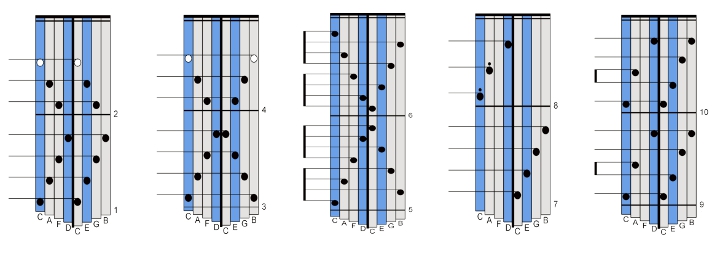When I was 10 years old, my father said “I’ll give you a dollar if you can go 10 seconds without thinking of a brown bear!” I jumped up from the dinner table, went to stand in the corner, and started chanting “White bear! White bear!” and got a huge laugh from my whole family.
But truth be told? I was actually thinking of brown bears the entire time I was trying to fill my mind with images and words of white bears.
Playing kalimba is a lot like that – thinking of white bears and brown bears at the same time.
I have often read that if you fill your heart and mind with love, there is no room for fear, or doubt, or hate, or thinking about the taxes that you are late filing. The idea behind this is that the human brain has a single central executive processor. While you can have about 7 different facts or ideas in short term or working memory, your central processor is a single thread that is manipulating the items in working memory.
But I don’t think the brain works exactly that way. Where is this central executive processor located? In one hemisphere or the other? Could it be a synthesis of structures and processes from both hemispheres? Or is it possible that we might have a central processor in each hemisphere?
Recall that the right hemisphere controls the left side of your body, and the left hemisphere controls the right side of your body. (If you ever figure out why that is, you’d probably be in line for a Nobel Prize – this is a fact that we can know and use, but we cannot yet explain.) Isn’t it possible that your right hemisphere can have a central processor for the left side of your body, and your left hemisphere can have one for the right side of your body? A dual processor system, each conveniently dedicated to one of your two kalimba-playing hands!
I contend that in order to play kalimba, you sort of need to have two separate processors in your brain going at once, one to control what your left hand is doing and one to control what your right hand is doing. And these two musical parts (managed by the two separate processors) need to be merged together. Without this integration, the music would fall apart.
Playing kalimba is true multi-tasking – it is not working on your homework for 30 seconds, and then answering a text for 30 seconds. It is more like answering a text with your right hand while you sign into your email account with your left hand. But those two processes are unrelated, and you might text your friend part of your email password or sign in incorrectly. I think the brain’s “dual central processors” can work very precisely when playing kalimba because in kalimba music the two parts are so interrelated.
This dual processor brain function (and the skills we can develop using it), is not something that comes right away – it must be cultivated. We do this by using simple devices or tricks at first, to help our brains and hands begin to encompass this new technique. Eventually we hope to be able to play complex parts that are related to each other in complex ways.

In the tablature above, the first two examples are basically “single processor” music – the left and right thumbs are very simply related (ie, by playing at the same time and moving in the same physical direction, or in the opposite direction in the second example). Those are huge tricks that make such playing very simple.
The middle example is a scale, which is made from the second example by introducing a slight time delay in the right hand part. It is still basically a “single processor” bit of music, even though it is exercising the left/right split in a deeper way.
The fourth bit of tablature shows a “trick” to enable us to get something more complex going between the left and right – but the right and left parts have been separated. This is a learning exercise, preparing us for the fifth and last bit of tablature which puts them together. The left and right parts are both very simple, but they are related to each other in a complex manner (this is a four against three part – four notes on the right hand in the same amount of time the left hand plays three notes). The “trick” is the pattern by which we start with left and right playing together, followed by right, then left, then right, and end the measure with left and right playing together again. By using this “trick” pattern, we are making a step in the direction of “two processor” music with more independent parts on the left and the right sides.
Much more to come on this topic dear to my heart and fundamental to kalimba playing.


Sign up for our newsletter and free resources with your email address:
We pinky promise not to spam you and to only send good stuff.
 Christmas in July 2025
Christmas in July 2025 Patriotic and American Music for Kalimba
Patriotic and American Music for Kalimba